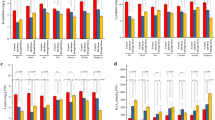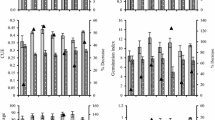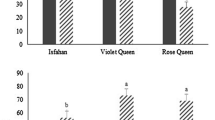Abstract
Four selected Amaranthus tricolor cultivars were grown under four irrigation regimes (25, 50, 80, and 100% field capacity) to evaluate the mechanisms of growth and physiological and biochemical responses against drought stress in randomized complete block design with three replications. Drought stress led to decrease in total biomass, specific leaf area, relative water content (RWC), photosynthetic pigments (chlorophyll a, chlorophyll b, chlorophyll ab), and soluble protein and increase in MDA, H2O2, EL, proline, total carotenoid, ascorbic acid, polyphenols, flavonoids, and antioxidant activity. However, responses of these parameters were differential in respect to cultivars and the degree of drought stresses. No significant difference was observed in control and LDS for most of the traits. The cultivars VA14 and VA16 were identified as more tolerant to drought and could be used for further evaluations in future breeding programs and new cultivar release programs. Positively significant correlations among MDA, H2O2, compatible solutes, and non-enzymatic antioxidant (proline, TPC, TFC, and TAC) suggested that compatible solutes and non-enzymatic antioxidant played vital role in detoxifying of ROS in A. tricolor cultivar. The increased content of ascorbic acid indicated the crucial role of the ASC–GSH cycle for scavenging ROS in A. tricolor.




Similar content being viewed by others
References
Repo-Carrasco-Valencia, R., Hellstrom, J. K., Pihlava, J. M., & Mattila, P. H. (2010). Flavonoids and other phenolic compounds in Andean indigenous grains: Quinoa (Chenopodium quinoa), kaniwa (Chenopodium pallidicaule) and kiwicha (Amaranthus caudatus). Food Chemistry, 120(1), 128–133.
Steffensen, S. K., Rinnan, A., Mortensen, A. G., Laursen, B., Troiani, R. M., Noellemeyer, E. J., Janovska, D., Dusek, K., Delano-Frier, J., Taberner, A., Christophersen, C., Inge, S., & Fomsgaard, I. S. (2011). Variations in the polyphenol content of seeds of field grown Amaranthus genotypes. Food Chemistry, 129(1), 131–138.
Faize, M., Burgos, L., Faize, L., Piqueras, A., Nicolas, E., Barba-Espin, G., Clemente-Moreno, M. J., Alcobendas, R., Artlip, T., & Hernandez, J. A. (2011). Involvement of cytosolic ascorbate peroxidase and Cu/Zn-superoxide dismutase for improved tolerance against drought stress. Journal of Experimental Botany, 62(8), 2599–2613.
White, D. A., Turner, N. C., & Galbraith, J. H. (2000). Leaf water relations and stomatal behavior of four allopatric Eucalyptus species planted in Mediterranean southwestern Australia. Tree Physiology, 20(17), 1157–1165.
Sircelj, H., Tausz, M., Grill, D., & Batic, F. (2007). Detecting different levels of drought stress in apple trees (Malus domestica Borkh.) with selected biochemical and physiological parameters. Scientia Horticulturae, 113(4), 362–369.
Sircelj, H., Tausz, M., Grill, D., & Batic, F. (2005). Biochemical responses in leaves of two apple tree cultivars subjected to progressing drought. Journal of Plant Physiology, 162(12), 1308–1318.
Liu, F., & Stutzel, H. (2002). Leaf water relations of vegetable amaranth (Amaranthus spp.) in response to soil drying. European Journal of Agronomy, 16(2), 137–150.
Sarker, U., Islam, M. T., Rabbani, M. G., & Oba, S. (2014). Genotypic variability for nutrient, antioxidant, yield and yield contributing traits in vegetable amaranth. Journal of Food, Agriculture and Environment, 12, 168–174.
Sarker, U., Islam, M. T., Rabbani, M. G., & Oba, S. (2015a). Variability, heritability and genetic association in vegetable amaranth (Amaranthus tricolor). Spanish Journal of Agricultural Research, 13(2), 1–8. https://doi.org/10.5424/sjar/2015132-6843.
Sarker, U., Islam, M. T., Rabbani, M. G., & Oba, S. (2015b). Genotype variability in composition of antioxidant vitamins and minerals in vegetable amaranth. Genetika, 47(1), 85–96.
Sarker, U., Islam, M. T., Rabbani, M. G., & Oba, S. (2016). Genetic variation and interrelationship among antioxidant, quality and agronomic traits in vegetable amaranth. Turkish Journal of Agriculture and Forestry, 40, 526–535.
Sarker, U., Islam, M. T., Rabbani, M. G., & Oba, S. (2017). Genotypic diversity in vegetable amaranth for antioxidant, nutrient and agronomic traits. Indian Journal of Genetics and Plant Breeding, 77(1), 173–176.
Sarker, U., Islam, M. T., Rabbani, M. G., & Oba, S. (2018a). Variability in total antioxidant capacity, antioxidant leaf pigments and foliage yield of vegetable amaranth. Journal of Integrative Agriculture, 17(5), 1145–1153.
Sarker, U., Islam, M. T., Rabbani, M. G., & Oba, S. (2018b). Phenotypic divergence in vegetable amaranth for total antioxidant capacity, antioxidant profile, dietary fiber, nutritional and agronomic traits. Acta Agriculturae Scandinavica Section B Soil and Plant Science, 68, 67–76.
Sarker, U., Islam, M. T., Rabbani, M. G., Oba, S. (2018c). Antioxidant leaf pigments and variability in vegetable amaranth. Genetika, 50(1), 209–220.
Ogbaga, C. C., Stepien, P., & Johnson, G. N. (2014). Sorghum (Sorghum bicolor) varieties adopt strongly contrasting strategies in response to drought. Physiologia Plantarum, 152(2), 389–401.
Sarker, U., & Oba, S. (2018d). Response of nutrients, minerals, antioxidant leaf pigments, vitamins, polyphenol, flavonoid and antioxidant activity in selected vegetable amaranth under four soil water content. Food Chemistry, 252, 72–83.
Zhao, F., Guo, S., Zhang, H., & Zhao, Y. (2006). Expression of yeast SOD2 in transgenic rice results in increased salt tolerance. Plant Science, 170(2), 216–224.
Lutts, S., Kinet, J. M., & Bouharmont, J. (1995). Changes in plant response to NaCl during development of rice (Oryza sativa L.) varieties differing in salinity resistance. Journal of Experimental Botany, 46(12), 1843–1852.
Bates, L. S., Waldren, R. P., & Teare, I. K. (1973). Rapid determination of free proline for water stress studies. Plant and Soil, 39(1), 205–208.
Bradford, M. M. (1976). A rapid and sensitive method for the quantification of microgram quantities of protein utilizing the principle of protein-dye binding. Analytical Biochemistry, 72(1-2), 248–254.
Ma, Y. H., Ma, F. W., Zhang, J. K., Li, M. J., Wang, Y. H., & Liang, D. (2008). Effects of high temperature on activities and gene expression of enzymes involved in ascorbate-glutathione cycle in apple leaves. Plant Science, 175(6), 761–766.
Velioglu, Y. S., Mazza, G., Gao, L., & Oomah, B. D. (1998). Antioxidant activity and total phenolics in selected fruits, vegetables, and grain products. Journal of Agricultural and Food Chemistry, 46(10), 4113–4117.
Chang, C. C., Yang, M. H., Wen, H. M., & Chern, J. C. (2002). Estimation of total flavonoid content in propolis by two complementary colorimetric methods. Journal of Food and Drug Analysis, 10, 178–182.
Chaves, M. M., & Oliveira, M. M. (2004). Mechanisms underlying plant resilience to water deficits: prospects for water-saving agriculture. Journal of Experimental Botany, 55(407), 2365–2384.
Achten, W. M. J., Maes, W. H., Reubens, B., Mathijs, E., Singh, V. P., Verchot, L., & Muys, B. (2010). Biomass production and allocation in Jatropha curcas L. seedlings under different levels of drought stress. Biomass and Bioenergy, 34(5), 667–676.
Farooq, M., Wahid, A., Kobayashi, N., Fujita, D., & Basra, S. M. A. (2009). Plant drought stress: effects, mechanisms and management. Agronomy for Sustainable Development, 29(1), 185–212.
Guerfel, M., Baccouri, O., Boujnah, D., Chaibi, W., & Zarrouk, M. (2009). Impacts of water stress on gas exchange, water relations, chlorophyll content and leaf structure in the two main Tunisian olive (Olea europaea L.) cultivars. Scientia Horticulturae, 119(3), 257–263.
Kadioglu, A., Saruhan, N., Sağlam, A., Terzi, R., & Acet, T. (2011). Exogenous salicylic acid alleviates effects of 554 long term drought stress and delays leaf rolling by inducing antioxidant system. Journal of Plant Growth Regulation, 64(1), 27–37.
Parida, A. K., & Das, A. B. (2005). Salt tolerance and salinity effects on plants: a review. Ecotoxicology and Environmental Safety, 60(3), 324–349.
Liu, H., Li, F., & Xu, H. (2004). Deficiency of water can enhance root respiration rate of drought sensitive but not drought-tolerant spring wheat. Agricultural Water Management, 64(1), 41–48.
Kato, M., & Shimizu, S. (1985). Chlorophyll metabolism in higher plants VI. Involvement of peroxidase in chlorophyll degradation. Plant & Cell Physiology, 26, 1291–1301.
Parida, A. K., Das, A. B., Sanada, Y., & Mohanty, P. (2002). Effects of salinity on biochemical components of the mangrove, Aegiceras corniculatum. Aquatic Botany, 80, 77–87.
Lutts, S., Kinet, J. M., & Bouharmont, J. (1996). NaCl-induced senescence in leaves of rice (Oryza sativa L.) cultivars differing in salinity resistance. Annals of Botany, 78(3), 389–398.
Jain, G., Schwinn, K. E., & Gould, K. S. (2015). Functional role of betalains in Disphyma australe under salinity stress. Environmental and Experimental Botany, 109, 131–140.
Reddy, A. R., Chaitanya, K. V., & Vivekanandan, M. (2004). Drought-induced responses of photosynthesis and antioxidant metabolism in higher plants. Journal of Plant Physiology, 161(11), 1189–1202.
Sharma, S., Lin, W., Villamor, J. G., & Verslues, P. E. (2013). Divergent low water potential response in Arabidopsis thaliana accessions Landsberg erecta and Shahdara. Plant, Cell & Environment, 36(5), 994–1008.
Christou, A., Manganaris, G. A., Papadopoulos, I., & Fotopoulos, V. (2013). Hydrogen sulfide induces systemic tolerance to salinity and non-ionic osmotic stress in strawberry plants through modification of reactive species biosynthesis and transcriptional regulation of multiple defense pathways. Journal of Experimental Botany, 64(7), 1953–1966.
Mittler, R. (2002). Oxidative stress, antioxidants and stress tolerance. Trends in Plant Science, 7(9), 405–410.
Bieker, S., & Zentgraf, U. (2013). Plant senescence and nitrogen mobilization and signaling. In Z. Wang & H. Inuzuka (Eds.), Senescence and senescence-related disorders (Vol. 16, pp. 53–83). Croatia: INTECH.
Mansour, M. M., & Ali, E. F. (2017). Evaluation of proline functions in saline conditions. Phytochemistry, 140, 52–68.
Bartwal, A., Mall, R., Lohani, P., Guru, S. K., & Arora, S. (2013). Role of secondary metabolites and brassinosteroids in plant defense against environmental stresses. Journal of Plant Growth Regulation, 32(1), 216–232.
Ma, G., Zhang, L., Matsuta, A., Matsutani, K., Yamawaki, K., Yahata, M., Wahyudi, A., Motohashi, R., & Kato, M. (2013). Enzymatic formation of ß-citraurin from ß-cryptoxanthin and zeaxanthin by carotenoid cleavage dioxygenase in the flavedo of citrus fruit. Plant Physiology, 163(2), 682–695.
Hamid, A. A., Aiyelaagbe, O. O., Usman, L. A., Ameen, O. M., & Lawal, A. (2010). Antioxidants: its medicinal and pharmacological applications. African Journal of Pure and Applied Chemistry, 4, 142–151.
Sen, P., Aich, A., Pal, A., Sen, S., & Pa, D. (2014). Profile of antioxidants and scavenger enzymes during different developmental stages in Vigna radiata (L.) Wilczek (Mungbean) under natural environmental conditions. International Journal of Plant Research, 4, 56–61.
Blokhina, O., & Fagerstedt, K. V. (2010). Oxidative metabolism, ROS and NO under oxygen deprivation. Plant Physiology and Biochemistry, 48(5), 359–373.
Hanson, P., Yang, R. Y., Chang, L. C., Ledesma, L., & Ledesma, D. (2011). Carotenoids, ascorbic acid, minerals, and total glucosinolates in choysum (Brassica rapa cv g. parachinensis) and kailaan (B. oleraceae Alboglabra group) as affected by variety and wet and dry season production. Journal of Food Composition and Analysis, 24(7), 950–962.
Espinoza, A., Martína, A. S., Lopez-Climentb, M., Ruiz-Laraa, S., Gomez-Cadenasb, A., & Casarettoa, J. (2013). Engineered drought-induced biosynthesis of α-tocopherol alleviates stress-induced leaf damage in tobacco. Journal of Plant Physiology, 170(14), 1285–1294.
Bettaieb, I., Sellami, I. H., Bourgou, S., Limam, F., & Marzouk, B. (2011). Drought effects on polyphenol composition and antioxidant activities in aerial parts of Salvia officinalis L. Acta Physiologiae Plantarum, 33(4), 1103–1111.
Lin, K. H., Chao, P. Y., Yang, C. M., Cheng, W. C., Lo, H. F., & Chang, T. R. (2006). The effects of flooding and drought stresses on the antioxidant constituents in sweet potato leaves. Botanical Studies, 47, 417–426.
Author information
Authors and Affiliations
Corresponding author
Ethics declarations
Conflict of Interest
The authors declare that they have no conflict of interest.
Electronic supplementary material
Supplementary Table S1
(DOCX 15 kb)
Rights and permissions
About this article
Cite this article
Sarker, U., Oba, S. Drought Stress Effects on Growth, ROS Markers, Compatible Solutes, Phenolics, Flavonoids, and Antioxidant Activity in Amaranthus tricolor. Appl Biochem Biotechnol 186, 999–1016 (2018). https://doi.org/10.1007/s12010-018-2784-5
Received:
Accepted:
Published:
Issue Date:
DOI: https://doi.org/10.1007/s12010-018-2784-5




